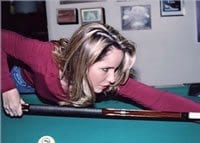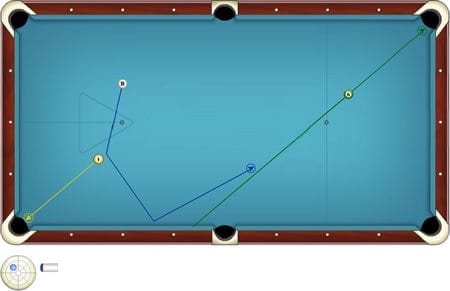 In this last article I want to focus on the absolute best tips I give during a lesson. Some of what I write is fundamental things, but I want to relay some tips that you may not hear all the time. I will let you know what to look for to play the smartest position possible, and offer a few tips that I figured out on my own after years of playing this game that help immensely during my pre-shot routine.
In this last article I want to focus on the absolute best tips I give during a lesson. Some of what I write is fundamental things, but I want to relay some tips that you may not hear all the time. I will let you know what to look for to play the smartest position possible, and offer a few tips that I figured out on my own after years of playing this game that help immensely during my pre-shot routine.
First, of course, are fundamentals. You know about stance, and what someone who is fundamentally sound looks like over the ball. I am not going to talk about stance here, or grip, bridges or arm position. There are hundreds of articles on those things, and I have always wanted to write something a little different than the standard information available anywhere.
Instead, I am writing about addressing the ball properly in the line of the shot. When I give lessons, only maybe 1 out of 20 players somewhat does this correctly. That is why it is my Number One tip when giving a lesson. In pool, like many other sports such as golf or bowling, consistency—doing the same thing over and over—is important. A person who plays golf would never haphazardly step into their stance, and someone who wants to bowl a strike would never approach the lane at any odd angle. Why do people do this in pool? I often watch someone come off their previous shot, walk around to their next one, and slide right into the shot.
You need to get down on each shot the same way, every time. Step back from the shot, standing in the line of the shot, and then step in the same way every time. Your approach to one shot should look exactly the same on the next shot you shoot. While you are standing up in the line of the shot, you should be looking at position for the next ball. Pinpoint where you would like the cue ball to end up and what angle you would like to have. How can you do this when you get off one shot, walk around to the next, and instantly get down on the ball!? Every time you are behind a shot, you should be chalking your cue stick, and formulating a concrete plan for that shot. This is your pre-shot routine. Giving yourself enough time to see the line, chalk your cue stick, and formulate a plan for the run out or safety play. It is difficult to describe a pre-shot routine. I have posted a link to the YouTube video at the end of the article to illustrate this for you.
In the video, you will hear me talk about visualization. This is the most important thing I do when playing position. It is one thing to see a shot and say to yourself that you would like to see the cue ball end up in a certain position on the table after your shot. I used to do that for years until one day I added a facet to that. Instead of just saying to yourself where you would like to place the cue ball in your pre-shot routine, actually visualize the cue ball moving along a path to where it needs to go. Before I shoot l, I determine where I want the cue ball to end up, but I also see it hit the object ball in the pocket, and then I visualize how it will come off the object ball, where it will hit the rail, and the angle it will come off that rail to get to the place I want it to go. When I first started doing this (after about seven years of playing), I saw that sometimes the end place where I picked for my cue ball to end up wasn’t reasonable. After I took the time to visualize the path that the cue ball would have to take, I realized that it just couldn’t get there. That is why adding the visualization part to playing position and not just identifying the end position of the cue ball is one of my greatest tips.
Next, when you get down on your shot, stay focused on the object ball and the exact spot where your cue ball needs to make contact to pocket the object ball. Do not get down on your shot looking only at the cue ball! Trust me, you will not hit the cue ball accurately with your cue stick if you do not get down and look at the entire length of the shot. With the entire shot in your perspective, and as long as you are addressing the ball properly, stepping into it straight, your body will naturally get in line with the shot. If you only get down on your shot looking at the cue ball, then the entire length of the shot is not within your sight, and you could get down on it on any sort of line.
Lastly, when you are finally ready to shoot, always look at the exact spot on the object ball where you want the cue ball to hit. You must never look at the cue ball last. You must trust that you will strike the cue ball where you have aimed—and you will—if your stroke is straight. If it isn’t, then you are missing and must practice to fix that separately.
The next part I would like to cover is playing smart position. I am going to discuss the concept of playing “in-line” of the next shot. There are generally two ways to play position for your next ball, and that is playing “in-line” or “crossing the line.” Look at the diagram below. You have ball-in-hand and you want to play the 1-ball first to the 6- ball. You have two options in placing ball-in-hand. The first diagram below is an example of one placement for the cue ball. This would be the incorrect choice. The line of the shot is the green line, the 6-ball. When figuring out where to place ball-in-hand for the next shot, you always want to choose the path where the cue ball will travel more closely this line of the 6-ball. You can see, if you were to place the ball as I have here and go to the two rails, you cross this line of the 6-ball.
This first diagram is an example of “crossing the line,” not what you want to do.
The second diagram below is where you would want to place the cue ball with ball-in-hand to get the best position on the 6-ball. In this diagram, the cue ball more naturally follows the line of the 6-ball shot. I added a little outside or left hand spin in this case, so the cue ball widens on the bottom rail and even follows the line more closely.
You can see in the above diagram that the cue ball path marked in blue more closely follows the line. This is important because that means that the shot is not wholly speed dependant. No matter how hard or soft you hit this ball you will most likely have a shot on the 6-ball because you followed the line. In the first diagram, you can see that you have to hit it perfectly to be on the line. Also, hit it too soft and you are going to have to back cut the 6-ball; hit it too hard and you may come underneath it. I go over these two diagrams on my YouTube video. Here’s the link: http://www.youtube.com/watch?v=4pU5vBK3kvI
I have enjoyed writing these articles for you this year! I hope that what I have written has helped you in some way, whether you are a SL3 or a SL7. Please, if you have anything you would like to share about any of my articles, or have anything to say in parting, write to me at tina@tinapawloski.com. Also, if you see me at an APA event, come up and say hello!


